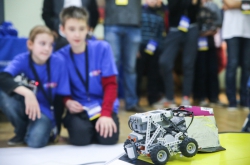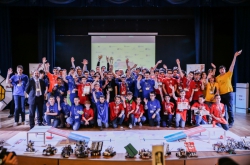This was the second season for the Tournament of Two Capitals; last time, the finals took place in Moscow. The tournament is comprised of several rounds. During the preliminaries, teams are selected according to their applications, then the best 20 teams of each city are selected in the qualification round. From these teams, the two select teams are formed, which compete in the finals.
There are two age groups in the tournament: students up to 14 years of age and students aged from 14 to 18. The younger ones participate in "King of the Hill" and "Bridges" categories, and the older ones in "Races" and "Swings." “King of the Hill” is, in fact, a robot battle that resembles sumo wrestling, where robots try to push each other off a small hill. In “Bridges”, two robots from the same team have to interact with each other: one paves bridges across a gap and the other travels across these bridges and grabs cargo. “Races” is a racing competition in which robots find their way along a route using sensors. The fourth competition, "Swings", also involves two robots: one must climb up a swing and grab a cylindrical weight from the top, while its partner keeps the swing at the right angle using its own weight. The robots are expected to work autonomously, without any help from their creators.
 Tournament of Two Capitals in St. Petersburg
Tournament of Two Capitals in St. Petersburg
In the finals, the two select teams compete in the same four categories; yet, on the second day of the tournament, they are to face the fifth “secret” challenge which is uncovered only a day prior to its conduct. This time, it was called the Fifth Element, and the teams had to use their robots to “save the world”. A racer robot had to move along a line to get the “fifth element” (represented by a sponge), then bring it to a particular point. Other robots help it reach this goal: the robot from “King of the Hill” has to climb a hill and push a can from it, the robot from "Swings" - keep the swing, and two robots from “Bridges” are to find the “fifth element” and give it to the racer robot. While the robots complete these challenges, the robot of Great Evil moves to their destination point. If a team doesn’t complete some task in full, it moves a bit faster, and if the Great Evil reaches its destination faster than the racer robot, Evil wins.
“Neither of the teams allowed that to happen. All of the participants stayed within the time-limit, and if they made mistakes, that was due to anxiety, not some attempt to cheat. We were really glad to respond to their wishes, as it is very important for us that children would take joy in the competition. This time, the refereeing of the fifth task was quite unconventional: judges from Moscow assessed the St. Petersburg team, and St. Petersburg judges - the Moscow team,” comments Nina Wunder, head judge and PhD student of the Department of Computer Science and Control Systems.
 Tournament of Two Capitals in St. Petersburg
Tournament of Two Capitals in St. Petersburg
ITMO.NEWS asked the trainers of teams to expand on how they prepared their students for the tournament, as well as on the significance of the event for novice roboteers in general.
According to Lidya Kobtseva, member of the tournament’s Methodological group and teacher at school no. 2086, Moscow’s Center of Pedagogical Proficiency puts a lot of effort in forming the city’s select team in Robotics. For instance, prior to the qualification and the final rounds of the tournament, they trained the participants via special three-day courses, where the students tested their robots on site, wrote programs for them and got feedback from trainers and their peers. Another purpose of these courses was to test the tournament’s procedure.
 Lidya Kobtseva
Lidya Kobtseva
Ms. Kobtseva adds that participation in such contests is great for trainers, as well, as they can share experience and practices. The Center of Pedagogical Proficiency also holds workshops for trainers, where they can access the schedule of the notable robotics competitions so as to better plan their students’ training. At large, Moscow’s fledgling roboteers can participate in some contest every month.
 Tournament of Two Capitals in St. Petersburg
Tournament of Two Capitals in St. Petersburg
In St. Petersburg, one of the tournament’s greatest achievements is that it has overreached the city, and now teams from the Leningrad region actively participate in it, as well. This year, their members constituted a third of the Northern Capital’s select team. After the first Tournament of Two Capitals, the Computer Center of supplementary education in Luga reported a three times increase in the number of children who’ve applied for robotics courses. Last year, the Luga Frontier team trained by Alexei Chistyakov, one of the center’s tutors, won the qualification round and participated in the finals in Moscow - which seems to have contributed to the increasing interest in robotics in Luga.

According to Alexei Chistyakov, students eagerly participate in the Tournament of Two Capitals despite it being more challenging than other similar contests. In the tournament, the "King of the Hill" and "Races" categories are more complex, and there are just no counterparts to “Swings” and “Bridges” tasks. For instance, in the "King of the Hill" task of the Tournament of Two Capitals the robots have to not just identify and tackle the opponent, but also climb the hill, and “Races” imply that the robots possess the ability to react to opponents’ actions and obstacles, as well as write programs for computing turns and turnarounds.
 Alexei Chistyakov
Alexei Chistyakov
“The main point of participating in the tournament lies in not winning, but self-development. It is like taking tests where you learn more than what you’ve got during your general training while preparing for them. During the period of training for the tournament and the tournaments’ rounds, students learn and remember a lot more. In a sense, the whole point of conducting the tournament is to discover talented children and give them this quantum leap. What is more, the children get to communicate with other roboteers, like-minded people, and this is what they really dig. Also, such competitions are great for promoting robotics amongst students and their parents. For instance, some parents from Luga came to the tournament to see what their children are interested in, and were thrilled to bits. They will tell their friends about it, they, in turn, will tell theirs, and so on,” shares Alexei Chistyakov.
He adds that for the purposes of training, he and his students have created test areas for the “King of the Hill” and “Bridges” categories from bits of vinyl, duct tape and tables - one can get information on the specs of test areas on the tournament’s website. Mr Chistyakov underlines that the trainer’s inventiveness is most important for the children’s development. If the trainer is interested, then he can properly encourage his students, as well.
This time, the Tournament of Two Capitals was won by Moscow’s select team, so the perpetual trophy once again changed its “residence”.





